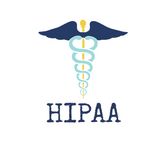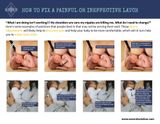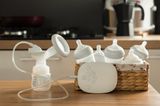Breastfeeding/chestfeeding is a normal natural experience of life. That doesn't mean it is always easy. Anatomical reasons for breastfeeding difficulties are relatively common both in the parent and the baby, including inverted nipples. This doesn't mean that inverted nipples mean you won't be able to breastfeed or chestfeed. Most parents with inverted nipples just need a little extra help while they are getting started.
Inverted nipples occur when the nipple is pulled inward instead of protruding outward, there are many variations of inverted nipples. Some are only very slightly inverted and will cause very little issues with breastfeeding/chestfeeding. Others can be very inverted but evert with by rolling the nipple between your fingers. These usually also don’t cause too much issue with breastfeeding/chestfeeding. Some inverted nipples are very stuck in their inverted position and some very large portion of the nipple and areola are inverted which can pose some challenges for breastfeeding/chestfeeding making it difficult for the baby to latch on and breastfeed/chestfeed properly. This post will help all with inverted nipples. While this can be frustrating and discouraging for new mothers or parents, there are several things you can do to prepare for and successfully breastfeed with inverted nipples.
Firstly, it's important to understand that inverted nipples do not necessarily mean you cannot breastfeed or chestfeed. In fact, a study conducted by the World Health Organization found that 95% of women with inverted nipples were able to successfully breastfeed their infants with the right preparation and techniques.
So, what can you do to prepare for breastfeeding with inverted nipples?
- Start early: It's best to start preparing for breastfeeding early, preferably during pregnancy. This will give you ample time to work on nipple stimulation techniques and get comfortable with the idea of breastfeeding or chestfeeding.
- Hand expression: Learning hand expression during pregnancy means that you will be ready if your baby is initially unable to latch or latch well in the first days after birth.
- Consult a lactation consultant: A lactation consultant can help you develop a plan for breastfeeding with inverted nipples. They can also guide you through various techniques to help your baby latch on correctly.
- Use nipple shields: Nipple shields are soft silicone covers that can be placed over the nipple to help your baby latch on more easily. A study published in the Journal of Obstetric, Gynecologic, & Neonatal Nursing found that nipple shields were effective in improving breastfeeding outcomes for parents with inverted nipples.
- Consider using a breast pump: A breast pump can help stimulate milk flow and maintain your milk supply if your baby is having difficulty latching on. A study published in the Journal of Human Lactation found that breast pumping was an effective method for women with inverted nipples to maintain their milk supply.
Now, let's talk about how to breastfeed with inverted nipples.
- Positioning: Finding the right position can make all the difference. Try different positions, such as the football hold or side-lying, until you find one that works best for you and your baby. While I don’t usually recommend the foot ball hold, it gives lots of space to hold the breast or chest tissue when for some people can encourage the nipple to evert or at least make the area around the nipple easier for the baby to fit into their mouth.
- Nipple stimulation: Gently massaging or rolling the nipple between your fingers can help it protrude more and make it easier for your baby to latch on.
- Breast compression: Applying gentle pressure to your breast while your baby is latched on can help encourage milk flow and make it easier for your baby to nurse.
- Patience: Breastfeeding or chestfeeding can take time and practice, especially with inverted nipples. Be patient with yourself and your baby and seek support from a lactation consultant or support group if needed.
What to do about pain while breastfeeding with inverted nipples
It is common that as the nipple everts during breastfeeding/chestfeeding or pumping that tiny tears in the nipple are created which can be painful. This can be an unfortunate side effect of breastfeeding or chestfeeding with inverted nipples but it doesn’t last for ever, the nipples will heal and you should be able to go on breastfeeding or chestfeeding without pain after that. Here are some things that you can do to decrease pain, risk of infection and speed healing.
Nipple damage is a common concern for many breastfeeding parents, particularly those with inverted nipples. Here's what you need to know about nipple damage and how to prevent and treat it when you have inverted nipples.
- Prepare before breastfeeding or pumping: Before you start breastfeeding or pumping, it's important to prepare your nipples. You can use your fingers or a breast pump to help draw out your nipples and make them more evert. Massaging your breasts and nipples can also help increase blood flow and promote the evertion of the nipple.
- Ensure proper latch or suction: A proper latch or suction is key to preventing nipple damage. Make sure your baby's mouth or the pump flange is positioned properly to create a seal around the nipple. If you're unsure, seek the help of a lactation consultant or other healthcare provider.
- Experiment with different positions: Trying different breastfeeding or pumping positions can help you find one that is comfortable and allows for a proper latch or suction.
- Use nipple cream or shields: Nipple cream or shields can help protect your nipples from friction and excessive suction. Consult a lactation consultant to make sure you are using a nipple shields correctly, if you are unable to get a deep latch these can be a good hold over to protect your nipple while you work on improving your latch.
- Take breaks: Breastfeeding or pumping can be tiring and can lead to nipple damage if done too frequently or for too long. Take breaks as needed and give your nipples time to rest and recover. While it is important to remove milk frequently to maintain supply. There are many ways of doing so and its okay to take a break from one if its causing you pain.
- Seek professional support: A lactation consultant or other healthcare provider can help you troubleshoot any breastfeeding or pumping issues and provide guidance on how to prevent or treat nipple damage.
It's important to remember that nipple damage can occur even with proper preparation and technique. If you experience any pain, discomfort, or bleeding, seek help from a healthcare provider. With proper care and attention, nipple damage can heal quickly and breastfeeding or pumping can continue successfully.
In conclusion, breastfeeding or chestfeeding with inverted nipples may require some extra preparation and techniques, but it is definitely possible. With the right support, patience, and practice, you can successfully breastfeed or chestfeed your newborn and provide them with the essential nutrients and antibodies they need for healthy growth and development.
- World Health Organization. (2018). Breastfeeding. Retrieved from https://www.who.int/health-topics/breastfeeding#tab=tab_1
- Amir, L. H., & Ingram, J. (2008). Nipple shields: A review of the literature. Journal of Human Lactation, 24(4), 320-328. doi: 10.1177/0890334408323037
- Cheung, S. Y., et al. (2017). Effectiveness of breast pump suction patterns for milk expression: A systematic review. Journal of Human Lactation, 33(4), 771-784. doi: 10.1177/0890334417706713
- Leeper, J., et al. (2016). The use of nipple shields for term infants: An integrative review. Journal of Obstetric, Gynecologic, & Neonatal Nursing, 45(5), 676-687. doi: 10.1016/j.jogn.2016.04.007




